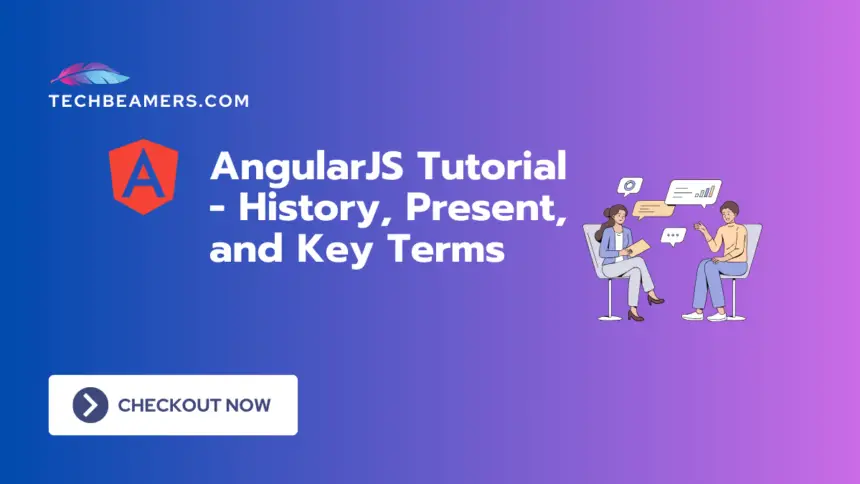Dive into our AngularJS tutorials, your key to mastering dynamic single-page applications. From the basics to advanced features, explore and elevate your web development skills effortlessly.
AngularJS Tutorials: Discovering the Magic of Angular
AngularJS, Google’s creation, empowers developers to build sleek websites effortlessly. This superhero for web development simplifies the creation of dynamic, impressive single-page applications using JavaScript.
History
AngularJS made its debut in 2010, transforming web development. Its popularity soared as it revolutionized tasks like connecting data and step-by-step website building.
| Version | Release Date | Notable Features |
|---|---|---|
| AngularJS | 2010 | Two-way data binding, directives |
| Angular | 2016 | Improved speed, enhanced features |
| Angular | 2019 | Ivy rendering engine, smaller bundles |
| Angular | 2022 | Strict mode, enhanced performance |
Present
Fast forward to today, and we have Angular, the evolved superhero in web development. Angular takes things up a notch with enhanced speed and even cooler features. This means developers can now effortlessly create robust, powerful, and incredibly smart applications, marking a significant leap in the world of web development. It’s like giving developers a high-speed toolset to build websites that not only look cool but also work seamlessly.
Key Terms
Find below are key terms that you can refer to any time from here.
Basic Terms
Two-way Data Binding: This is like magic that helps the webpage and the data talk to each other without needing a translator.
Dependency Injection: Think of it like LEGO blocks – it helps put together different parts of your website without making a mess.
Note: In AngularJS (and in many other frameworks that use dependency injection (DI)), the DI is a design pattern that allows components to be loosely coupled and easily interchangeable. The analogy with LEGO blocks implies that just as LEGO blocks can be connected and combined to build various structures. It allows you to inject and combine different components or services in your application.
Directives: These are like secret codes you add to regular HTML to make it do cool tricks and dances.
Controllers: Imagine this as the director of your webpage, telling things where to go and what to do.
Scope: It’s like the playground where your webpage elements can play together and share toys (data).
Intermediary Terms
Services: These are like special helpers that do important jobs, and you can use them in different parts of your webpage.
Modules: Think of modules like containers where you organize your webpage into tidy sections.
Templates: This is the blueprint for your webpage. It shows how everything should look and where things should go.
Expressions: These are like emojis for your webpage – they show feelings and make things lively.
Filters: Filters are like Instagram for your data. They make it look cool before showing it on your webpage.
Routing: It’s like having a roadmap for your webpage, telling users where to go when they click on things.
Most Common Terms Used in AngularJS Tutorials
ng-app: This is like telling your webpage, “Hey, this is where the fun begins!”
ng-model: It’s like a string tying your data to your webpage, so they never lose touch.
ng-repeat: It’s like a copy machine for your HTML, making more of the same thing with just a line of code.
$scope: This is the messenger between the director (controller) and the elements in your webpage.
$http: Imagine this as a superhero that brings things from the internet to your webpage.
$rootScope: It’s like a big brother that watches over everything on your webpage.
Directives (ng-if, ng-show, ng-hide): These are like the traffic signals for your webpage elements – showing or hiding them as needed.
Expert Terms
MVC Architecture: It’s the master plan to keep everything organized – Models, Views, Controllers.
Transclusion: This is like bringing a friend into a secret club, and embedding content into directives.
Digest Cycle: Think of it as a superhero power that detects and applies changes in your data.
Testing (Jasmine, Karma): It’s like making sure all the pieces of your webpage play nicely together by doing some checks.
Dynamic Forms: Creating forms that are like talking to your users and changing based on what they say.
Angular CLI: This is like a magic wand for developers, helping them do things faster and with less hassle.
Lazy Loading: It’s like saving energy by only loading the parts of your webpage when you need them.
Internationalization (i18n) and Localization (l10n): Make your webpage speak different languages, like a multilingual genius.
Web Components: These are like building blocks that can be used in different places and by different frameworks.
Ahead-of-Time (AOT) Compilation: It’s like converting your secret code (Angular code) into something everyone can understand before showing it off.
RxJS (Reactive Extensions for JavaScript): It’s like making your webpage a good listener, handling multiple things at once.
Angular Material: It’s a fancy toolbox with cool gadgets for making your webpage look slick and stylish.
List of Essential AngularJS Tutorials
Here, we have laid down some of the main AgularJS tutorials that can quickly help you build this skill.
- 100+ AngularJS Interview Questions
- Your First AngularJS Application
- AngularJS Overview and Quick Start Guide
- Learn to Use AngularJS APIs with Examples
All the very best,
Team TechBeamers









